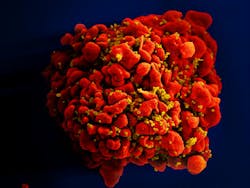A subset of white blood cells, known as myeloid cells, can harbor HIV in people who have been virally suppressed for years on antiretroviral therapy, according to findings from a small study supported by the National Institutes of Health.
In the study, researchers used a new quantitative method to show that HIV in specific myeloid cells—short-lived monocytes and longer-lived monocyte-derived macrophages—can be reactivated and infect new cells. The findings, published in Nature Microbiology, suggest that myeloid cells contribute to a long-lived HIV reservoir, making these cells an important but overlooked target in efforts to eradicate HIV.
In the study, researchers first measured HIV DNA in myeloid cells in a sample of 30 participants with HIV, all of whom were virally suppressed and had been on antiretroviral therapy for at least 5 years. They found detectable levels of HIV genetic material in monocytes and macrophages, though the levels were much lower than those observed in CD4 T cells. In some participants, the HIV genetic material found in monocytes was intact, which suggests it may be capable of infecting other cells if reactivated.
They then used the new quantitative method they developed to directly measure viral spread from HIV found in myeloid cells. The researchers isolated monocytes from blood samples taken from 10 participants and nurtured the monocytes in cultures that contained antiretroviral drugs, to replicate the participants’ baseline physical state. After the monocytes differentiated into macrophages, the researchers introduced an immune activating agent and then added fresh white bloods cells to allow for the virus to spread to new cells.
The researchers collected samples from the cell cultures several times over the next 12 days. They included checkpoints throughout the process to ensure that infected CD4 T cells did not interfere with their measurements.
The results showed that cultures from five of the 10 participants had detectable HIV genetic material in monocyte-derived macrophages that could be reactivated to infect other cells and produce more virus. The participants who had these reactivatable reservoirs of HIV in monocyte-derived macrophages had higher overall levels of HIV DNA material.
Follow-up data from three participants showed that this reservoir can be long-lived, harboring latent HIV for months to several years. These reservoirs were stable and could be reactivated over time, indicating that monocyte-derived macrophages could contribute to viral rebound if antiretroviral treatment is disrupted.

